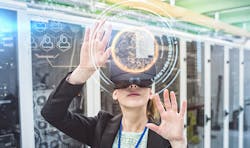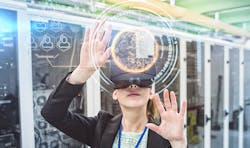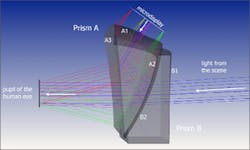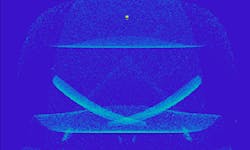Freeform optical design software speeds AR and VR headsets to market
Over the past few decades, advances in optical fabrication and measurement have moved aspheric and freeform optical surface design from theory to reality, helping to push the augmented reality (AR) and virtual reality (VR) industries forward. Freeform optics are used in both VR and AR optical designs and can help solve several challenges, including designing for headset size and weight and stray light considerations. And, in the case of AR, there are some additional challenges layered on when factoring in the delicate balance between light from the real world versus light from the microdisplay and what is viewed at the eye, with the ultimate goal of a microdisplayed image overlaid on the real scene.
An optical design for an AR headset in OpticStudio. Prism A has three freeform surfaces, and Prism B has two freeform surfaces.
Freeform -opticals design software and virtual prototyping are helping to reduce design iterations and repeated prototypes, cutting time to market and AR/VR development costs. For example, the non-sequential mode in OpticStudio supports stray-light analysis. Optical designers can apply finishes and coatings to surfaces, import CAD models of the housing into the system, and use different kinds of illumination. Optimization of the freeform surfaces and system geometry can minimize the amount of stray light that reaches the eye.
A detector in OpticStudio showing stray light that could reach the eye in the AR prism design.
Solving stray-light problems requires close coordination between the optical and mechanical models. Zemax Virtual Prototyping bridges the divide between optical design and mechanical design. It’s the only solution to create a working virtual prototype of the entire optomechanical product—not just the optical or mechanical components alone. And that’s critical in a cutthroat industry like AR/VR.
New guide: Optical design challenges in virtual and augmented reality
Designers creating AR/VR headsets cannot afford setbacks in the product development cycle. There is heavy competition, consumer demand, and funding to be secured. Read our in-depth article on how freeform-optics design software and virtual prototyping are specifically solving pain points for AR/VR headset designers and helping them to get to market faster.
You will learn:
- Information about where AR and VR sit on the Gartner Hype Cycle right now
- Details about the challenges of designing for VR and the unique challenges associated with designing for AR
- An example AR headset design
- How to design smaller and lighter headsets
- The requirements of optical -design software packages for designers working on these systems




